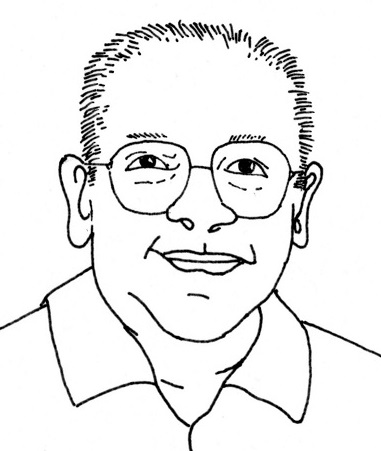
I asked the students to transfer their data to thumb drives and bring them to class the next day, when we would go over how to analyze the data. What I didn’t realize was that some students had discarded used components on the floor, leaving them as trash. And what I also didn’t know was that Thự was intrigued by the diffraction patterns and wanted to create more patterns, so that at the end of class she went to the back of the room and harvested many of the discarded batteries, LEDs, and, most importantly, diffraction gratings. She took them home, waited for sunset, and started playing with them in a darkened room.

RL5-W5020 white LED, powered by a 3 V lithium battery, as observed through a double-diffraction grating. Bùi Anh Thự, May 21-22, 2009.
At the beginning of class the next day, Thự was the only student who brought in data. I looked at one of the double-dispersion pictures of the LED, which she took against a dark background. “Could I use this in discussing the data with the class?” I asked. “Yes,” replied Thự. And so it was that during the second hour of class, Thự’s double-dispersion image was projected for all to see. We reproduce it here as the DOUBLE DIFFRACTION GRATING image. As Prof. Thai videoed the proceedings, I started discussing the image, and loaded it into the data analysis software. While the screen of Thự’s data wasn’t captured while in Hanoi, a screen showing spectra for blank and absorbance of Methylene Blue appears below to give some idea of what was being projected.

Data analysis software used with the “cell phone spectrometer” experiment. Image originally published in the Journal of the Analytical Sciences Digital Library, entry 10059, open access (2009).
It dawned on me that I was seeing something unusual, something that might solve a problem of long-standing. As the order number increased, the throughput went down, but the dispersion increased. Thus, there was a trade-off among resolution, throughput, and dynamic range.
I did not recognize at the time that control of exposure time was a problem. In 2009, simple “point and shoot” cameras and early cell phone cameras automatically adjusted exposure to maintain a pleasing appearance, thus destroying the ability to measure the absolute intensity of light. Since that time, exposure control has come to the software systems used by widely available digital cameras. But back then, I only vaguely understood and explained the exposure problem to the class.
I then said, “If we could figure out how to get a lot of orders to look at, we could optimally trade off throughput, resolution, and dynamic range.” This trade-off had hounded users of array detectors since their invention in 1973. At which point, Bùi Anh Thự quietly said, “Show the video!” “Video? What video?” I thought, in a state of confusion because I had seen only the still image from the double dispersion grating.
Thự came to the front of the room and opened a second file from the thumb drive. The video she shot the evening before looked at light transmitted through several gratings, one adjacent to the LED, the other two just in front of her camera lens. It showed some of the most glorious multi-order spectra imaginable. She had also taken some stills, the best of which, what I consider to be the founding image of SpectroClick, is shown here:

LED viewed through 3 stacked double-dispersion gratings. Taken by Bùi Anh Thự
May 21-May 22, 2009, and displayed to the K51 class, Hanoi University of Science Faculty of Chemistry, May 22, 2009.
It was hard for me to finish class after seeing the multi-order spectral pattern for the first time. Keep in mind that all I expected to see was an image like the first DOUBLE DISPERSION GRATING image above, but instead I saw the complex array with the capability of solving the long-standing instrumentation performance trade-off problem. At the end of class, I stepped off the dais, walked straight to Thự, and said, “We’ve got to protect your intellectual property rights. You just made a patentable invention.” She responded in disbelief, “I did?”
Over the following days and weeks, the Faculty of Chemistry and Hanoi University of Science indicated no financial or equity interest in the invention. We filed a disclosure with the University of Illinois. By late fall, I sent a small optical bench to Thự in Hanoi so she could work with the diffraction gratings to get an understanding of how they function, which neither of us understood at the time. While still an undergraduate, Thự came to Champaign-Urbana for ten weeks in the summer of 2010 to work on moving from an ingenious idea to a user-friendly instrument.
The initial spectrometer that I designed in the spring of 2010 failed – I hadn’t recognized that the LED makes a virtual image behind the grating, and the camera lens is central to imaging. Thự straightened this out, and Rob Brown of the School of Chemical Sciences Machine Shop machined a more plausible design (jointly designed by Bùi, Scheeline, and Brown). By mid-July of 2010, we had an arrangement that has since been the core of SpectroClick’s hardware technology.
Unlike any precedent spectrometric approach, dynamic range is not limited by detector dynamic range. Bùi Anh Thự broke a 36-year-old logjam, and is thus co-founder of SpectroClick. She returned to Urbana-Champaign in the fall of 2013 to continue instrument development. That year, we won the FACSS Innovation Award, recognizing this new technology. Bui Anh Thu now lives in Hanoi, Vietnam and is Program Coordinator at Newton School, an international high school with instruction in both Vietnamese and English.

SpectroClick, Inc. was co-founded by Scheeline and Bùi on September 11, 2011. United States Patent 8,885,161, “Energy Dispersion Device,” was granted to Alexander Scheeline and Bui Anh Thu on November 11, 2014.
As shown in DOUBLE DIFFRACTION GRATING, it is obvious that the image is saturated in the central, zero-order image of the LED. It is less obvious, but true, that several of the first-order images (the eight images of the LED, showing some “rainbow” effect around the central white dot) are saturated in part, but the red end of the spectrum is not saturated. In the analysis software, it was clear that such reduced saturation occurred, and that the second order spectra (even further out) were out of saturation.
Ever since working in Stan Crouch’s lab at Michigan State University in the 1970s, I’d been taught, and then taught my students, that one needed diode arrays with deep wells to do absorption spectrometry because of the precision required in measuring intensity and intensity ratios. But here was a way to get dynamic range from having many orders to choose from simultaneously. But what about precision? As the order number increased, the amount of signal averaging one could do also increased! So close to 100% T, one could average information from the high orders, getting good resolution and a good reference intensity, and then when a sample was in place, at high %T, the same pixels could be used to measure transmittance. If absorbance was high, the previously saturated pixels would come out of saturation, so that lower resolution could be used to allow precise measurement of the lower intensities.
SpectroBurst™ spectroscopy uses the 12-fold symmetric set of orders to provide a wide range of throughput in a single exposure, so that the dynamic range of the system is the product of the dynamic range of the detector and the grating throughput. Resolution depends on optical aberrations, entrance aperture size, light collimation prior to the grating, and focusing of the camera. Whether resolution is set by the optics or by the size of observation pixels depends on the specific system. Unlike any precedent spectrometric approach, dynamic range is not limited by detector dynamic range.






